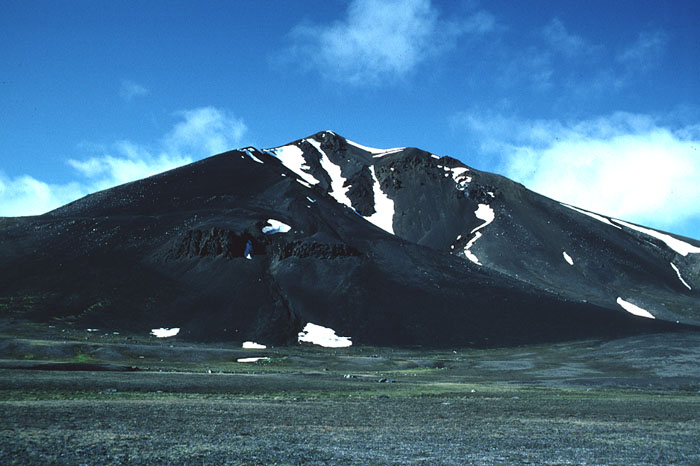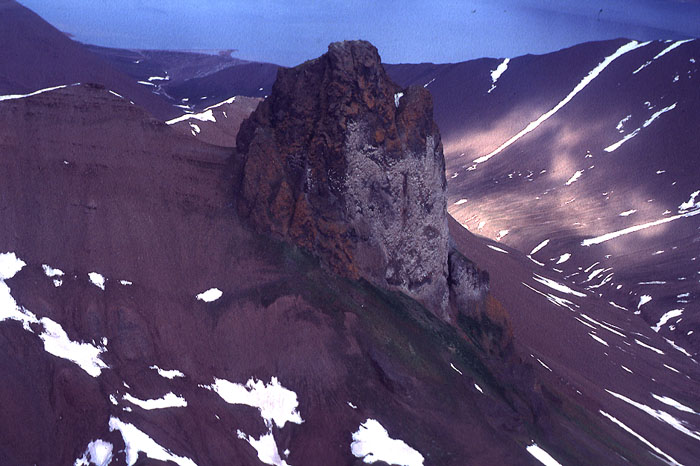5. QUATERNARY VOLCANIC AND SUBVOLCANIC ROCKS
WINFRIED K. DALLMANN
5.1 General remarks 5.2 Lexicon of lithostratigraphic units 5.1 General remarksVolcanic activity of Quaternary age occurred in northwestern Spitsbergen. Remains of three volcanic features are preserved on, or in the vicinity of, the Breibogen Fault (Fig. 1-05), a major north-south directed fault separating Devonian sediments from metamorphic Caledonian basement rocks. Movements along this fault date back to at least the Devonian.Back on top 5.2 Lexicon of lithostratigraphic unitsBOCKFJORDEN VOLCANIC COMPLEX (Q-01)
DISTRIBUTION shown on fig. 4-07 STATUS OF UNIT: Formal FIRST USE OF NAME: Here CURRENT DEFINITION: Skjelkvåle et al. 1989 SYNONYM(S) AND REFERENCE(S): None ORIGIN OF NAME: Bockfjorden: A fiord in northwestern Spitsbergen, a bifurcation of Woodfjorden TYPE AREA: Bockfjorden and its environments, northwestern Spitsbergen STRUCTURAL SETTING: Breibogen Fault and associated structures VOLCANIC AGE: Pleistocene (see individual eruptive centres) OVERLYING UNIT(S): None HOST UNIT(S): Andrée Land Group (Devonian), Pre-Old Red SUPERIOR UNIT: None OTHER USE OF NAME: Bockfjorden anticline (Gee 1972): A basement anticline paralleling Bockfjorden, west of the Breibogen Fault. The name is informal and little used. MAIN LITHOLOGIES: Basaltic pyroclastics and lava DESCRIPTION: The complex consists of three separate eruptive centres (Sverrefjellet, Halvdanpiggen and Sigurdfjellet) within a distance of 20 km. The centres show varying volcanic and subvolcanic features and are preserved at different erosional levels, all from the eroded remains of stratovolcano to subvolcanic vents. SVERREFJELLET VOLCANO (Q-02) DISTRIBUTION shown on fig. 4-07 STATUS OF UNIT: Formal FIRST USE OF NAME: Hoel & Holtedahl 1911: Le volcan de la Baie Bock [Mt. Sverre] CURRENT DESCRIPTION: Skjelkvåle et al. 1989 SYNONYM(S) AND REFERENCE(S): None ORIGIN OF NAME: Sverrefjellet: The ruin of a volcano west of Bockfjorden, northwestern Spitsbergen, named after an Old Norse king VOLCANIC AGE, REFERENCES AND DATING METHODS: Hoel & Holtedahl 1911: Post-glacial; morphological (mis)interpretation. Gjelsvik 1963: Partly subglacial; from the existence of pillow lavas. Burov & Murašsov 1964 (unpubl.): 0.01-0.2 Ma; geomorphological analysis. Halvorsen 1972: <0.7 Ma; palaeomagnetology. Burov & Zagruzina 1976: < 1 Ma; K-Ar radiometric age determination. Skjelkvåle et al. 1989: 0.1-0.25 Ma, comparative studies of glaciation episodes, erosion and morphology HOST UNIT(S): Pre-Old Red SUPERIOR UNIT: Bockfjorden Volcanic Complex OTHER USE OF NAME: None DIMENSIONS: Elevation above sea level: 20-506 m. Area: Subcircular, ca. 7 km2 (3 km across) MAIN LITHOLOGIES: Basaltic pyroclastics and lavas DESCRIPTION: The Sverrefjellet Volcano (Fig. 5-01) is the ruin of a stratovolcano constructed of primitive alkali basaltic pyroclastics (scoria, lapilli, bombs) with subordinate pahoehoe lavas rich in xenoliths derived from the upper mantle and lower crust. The occurrence of interbedded pillow lavas and pahoehoe flows indicates that the volcano grew concurrently with the rise of the surrounding glaciers. Glacial debris occurs on its flanks. Reworked material from the volcano forms marine terraces below the eastern slope at Bockfjorden at 5-60 m above sea level. Though reminiscent of a primary volcanic shape, the present outline of the mountain is the result of erosion. The surface is 80% covered with frost-weathered material, while 20% is made up of lava surfaces. Lava flows are 1-3 m thick and may form successions of up to 15 flows. Most seem to be derived from flank eruptions. A dike is exposed in an eroded valley side on the southeastern flank. HALVDANPIGGEN ERUPTIVE CENTRE (Q-03) DISTRIBUTION shown on 4-07 STATUS OF UNIT: Formal FIRST USE OF NAME: Skjelkvåle et al. 1989 CURRENT DESCRIPTION: Skjelkvåle et al. 1989 SYNONYM(S) AND REFERENCE(S): None ORIGIN OF NAME: Halvdanpiggen (transl. “The Peak of Halvdan”): A volcanic pipe in Riisefjella east of Bockfjorden, northwestern Spitsbergen, named after an Old Norse king. The associated volcanic features Olavstårnet (transl. “The Tower of Olav”) and Haraldknattane (transl. “The Humps of Harald”) are also named after ancient kings. VOLCANIC AGE, REFERENCES AND DATING METHODS: Halvorsen 1972: >0.7 Ma; palaeomagnetology. Skjelkvåle et al. 1989: Older than Sverrefjellet; concluded from its deeper erosion and greater degree of weathering HOST UNIT(S): Andrée Land Group (Devonian) SUPERIOR UNIT: Bockfjorden Volcanic Complex OTHER USE OF NAME: None DIMENSIONS: Elevation above sea level: 580-834 m. Area: Subcircular, 0.012 km2 (400 m across) MAIN LITHOLOGIES: Basaltic pyroclastic breccia DESCRIPTION: The Halvdanpiggen Eruptive Centre (Fig. 5-02) is a complex of vents and high-level intrusives in Halvdandalen (Riisefjella). The largest body is Halvdanpiggen itself, a volcanic neck 200 m across, consisting of a pyroclastic breccia of basaltic blocks and 60-70 % angular highpressure xenoliths. The central section of Halvdanpiggen is intruded by aphanitic, non-vesicular basalts weathering with a fanning columnar jointing. Small outcrops of pyroclastics and basalt around the neck suggest that the actual diameter of the vent is ca. 400 m. Halvdanpiggen is interpreted to be a complex, deeply eroded diatreme or volcanic conduit. SIGURDFJELLET ERUPTIVE CENTRE (Q-04) DISTRIBUTION shown on 4-07 STATUS OF UNIT: Formal FIRST USE OF NAME: Skjelkvåle et al. 1989 CURRENT DESCRIPTION: Skjelkvåle et al. 1989 SYNONYM(S) AND REFERENCE(S): None ORIGIN OF NAME: Sigurdfjellet: A mountain ridge consisting of volcanic rocks at Vonbreen, northwestern Spitsbergen, named after an Old Norse king VOLCANIC AGE, REFERENCES AND DATING METHODS: Skjelkvåle et al. 1989: 0.1-0.25 Ma; indirectly from of morphology and degree of weathering in comparison with Sverrefjellet HOST UNIT(S): Andrée Land Group (Devonian), Pre-Old Red SUPERIOR UNIT: Bockfjorden Volcanic Complex OTHER USE OF NAME: None DIMENSIONS: Elevation above sea level: 910-1,162 m. Area: Elongate, 4.5 km long, 200-250 m wide MAIN LITHOLOGIES: Basaltic pyroclastics DESCRIPTION: The Sigurdfjellet Eruptive Centre is an elongate ridge on – although normal to – the Breibogen Fault. It cuts across the fault and overlies Devonian rocks to the east, and Proterozoic basement rocks to the west of it. Back to top |

